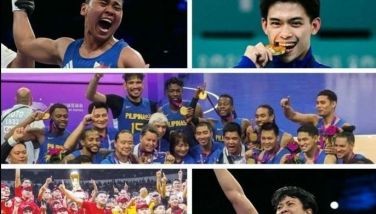Snakepit awaits Pacquiao in LA

May 17, 2003 | 12:00am
It won’t be friendly territory when International Boxing Federation (IBF) superbantamweight champion Manny Pacquiao steps into the ring to face Emmanuel (The Butcher) Lucero of Mexico at the historic Grand Olympic Auditorium in Los Angeles on July 26.
The Olympic is a notorious snakepit for visiting fighters opposing Mexicans or Latinos. Fans who patronize the boxing facility are mostly of Mexican descent and unforgiving when expressing partisanship. They are shameless, loud, and scandalous.
Boxing News writer Jim Brady recalled that in 1980, the Auditorium fans drained cups of urine on Welshman Johnny Owen as he was laid out on a stretcher, being rushed to a hospital after losing consciousness in a 12th round knockout loss to world bantamweight titlist Lupe Pintor. Owen died of head injuries a few days later.
"At the Olympic, that’s what they (fans) want-your sweat and blood," said Brady. "Boxing here is a blood sport. It’s tough to sell a safety-first technician to the crowd in blood ‘n’ guts L.A (where) the late Johnny Owen got cups of urine thrown on him as he was stretchered out."
In 1964, Hiroyuki Ebihara of Japan upset the Olympic fans when he pounded out a close win on points over local favorite Efren (Alacran) Torres of Mexico. The decision sparked a riot. Rows of heavy steel chairs in the balcony were ripped up and hurled onto the main floor along with large billboards torn from the walls and other objects, recounted Jack Hawn of United Press International in Boxing Today magazine.
"As I reported the violence, a large mustard jar crashed on the wooden ledge in front of me, exploding like a bomb and sending glass and mustard everywhere," said Hawn. "As I wiped my face, shards of glass cut it, my suit was ruined. Fires broke out and a six-foot retaining wall was pushed onto a back row of seats. Soon police took charge. Los Angeles Times columnist Sid Zif called the destruction ‘unparalleled in Los Angeles sports history.’ Mexican and Chicano fighters have dominated Olympic rings for decades and unpopular decisions against them have resulted in other riots at the Olympic but none as bad as the one in 1964."
Because the fans scream for blood, it’s no wonder that the Olympic has been plagued by ring fatalities. Owen, Alejandro Lavorante, and Kiko Bejines were fighters who died from injuries suffered in the Olympic ring.
The Olympic held its inaugural show on Aug. 5, 1925. Built exclusively for boxing, it is located on Grand Avenue, at 18th, half a mile north of the University of Southern California, in downtown Los Angeles. The Olympic stands 95 feet tall at its peak with 60,000 square feet inside, almost 10,000 seats, and 8-inch thick concrete walls that, according to Hawn, make it look like a mighty fortress. When it was constructed, the Auditorium was the only boxing facility with running water at ringside.
In 1932, the boxing and wrestling events at the Los Angeles Olympics were staged at the Auditorium.
The first world title fight at the Olympic featured Tod Morgan defeating Santiago Zorilla for the junior lightweight crown in 1929. Then, Freddie Miller figured in a pair of world featherweight championship bouts in 1933, beating Baby Arizmendi and Filipino Speedy Dado.
No Filipino has won a world title fight at the Olympic. Dado was the first to fall and the second was Bobby Berna who floored Jaime Garza, a hometown hero of Mexican descent, in the first round only to be knocked out in the second in a junior featherweight title match in 1983.
Record books show that legendary world champions Barney Ross, Henry Armstrong, Archie Moore, Don Jordan, Emile Griffith, Carlos Palomino, Joe Brown, Danny (Little Red) Lopez, Rafael (Bazooka) Limon, Julio Cesar Chavez, Bobby Chacon, Eder Jofre and Pone Kingpetch saw action at the Olympic.
The Auditorium may not be as glitzy as a fancy Las Vegas facility but it’s a boxing haven that’s as historic as it is legendary.
Pacquiao will invade the Auditorium in July, hoping to leave his own imprint in boxing history as the first Filipino to win a world title fight at the Olympic. He’ll go up against a Mexican and a hostile crowd. But Pacquiao promises to be ready for war because that’s exactly what lies ahead in the biggest test of his ring career.
The Olympic is a notorious snakepit for visiting fighters opposing Mexicans or Latinos. Fans who patronize the boxing facility are mostly of Mexican descent and unforgiving when expressing partisanship. They are shameless, loud, and scandalous.
Boxing News writer Jim Brady recalled that in 1980, the Auditorium fans drained cups of urine on Welshman Johnny Owen as he was laid out on a stretcher, being rushed to a hospital after losing consciousness in a 12th round knockout loss to world bantamweight titlist Lupe Pintor. Owen died of head injuries a few days later.
"At the Olympic, that’s what they (fans) want-your sweat and blood," said Brady. "Boxing here is a blood sport. It’s tough to sell a safety-first technician to the crowd in blood ‘n’ guts L.A (where) the late Johnny Owen got cups of urine thrown on him as he was stretchered out."
In 1964, Hiroyuki Ebihara of Japan upset the Olympic fans when he pounded out a close win on points over local favorite Efren (Alacran) Torres of Mexico. The decision sparked a riot. Rows of heavy steel chairs in the balcony were ripped up and hurled onto the main floor along with large billboards torn from the walls and other objects, recounted Jack Hawn of United Press International in Boxing Today magazine.
"As I reported the violence, a large mustard jar crashed on the wooden ledge in front of me, exploding like a bomb and sending glass and mustard everywhere," said Hawn. "As I wiped my face, shards of glass cut it, my suit was ruined. Fires broke out and a six-foot retaining wall was pushed onto a back row of seats. Soon police took charge. Los Angeles Times columnist Sid Zif called the destruction ‘unparalleled in Los Angeles sports history.’ Mexican and Chicano fighters have dominated Olympic rings for decades and unpopular decisions against them have resulted in other riots at the Olympic but none as bad as the one in 1964."
Because the fans scream for blood, it’s no wonder that the Olympic has been plagued by ring fatalities. Owen, Alejandro Lavorante, and Kiko Bejines were fighters who died from injuries suffered in the Olympic ring.
The Olympic held its inaugural show on Aug. 5, 1925. Built exclusively for boxing, it is located on Grand Avenue, at 18th, half a mile north of the University of Southern California, in downtown Los Angeles. The Olympic stands 95 feet tall at its peak with 60,000 square feet inside, almost 10,000 seats, and 8-inch thick concrete walls that, according to Hawn, make it look like a mighty fortress. When it was constructed, the Auditorium was the only boxing facility with running water at ringside.
In 1932, the boxing and wrestling events at the Los Angeles Olympics were staged at the Auditorium.
The first world title fight at the Olympic featured Tod Morgan defeating Santiago Zorilla for the junior lightweight crown in 1929. Then, Freddie Miller figured in a pair of world featherweight championship bouts in 1933, beating Baby Arizmendi and Filipino Speedy Dado.
No Filipino has won a world title fight at the Olympic. Dado was the first to fall and the second was Bobby Berna who floored Jaime Garza, a hometown hero of Mexican descent, in the first round only to be knocked out in the second in a junior featherweight title match in 1983.
Record books show that legendary world champions Barney Ross, Henry Armstrong, Archie Moore, Don Jordan, Emile Griffith, Carlos Palomino, Joe Brown, Danny (Little Red) Lopez, Rafael (Bazooka) Limon, Julio Cesar Chavez, Bobby Chacon, Eder Jofre and Pone Kingpetch saw action at the Olympic.
The Auditorium may not be as glitzy as a fancy Las Vegas facility but it’s a boxing haven that’s as historic as it is legendary.
Pacquiao will invade the Auditorium in July, hoping to leave his own imprint in boxing history as the first Filipino to win a world title fight at the Olympic. He’ll go up against a Mexican and a hostile crowd. But Pacquiao promises to be ready for war because that’s exactly what lies ahead in the biggest test of his ring career.
BrandSpace Articles
<
>
- Latest
- Trending
Trending
Latest
Trending
Latest
Recommended






























